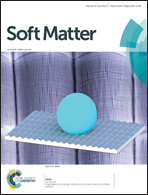Drag crisis moderation by thin air layers sustained on superhydrophobic spheres falling in water†
Abstract
We investigate the effect of thin air layers naturally sustained on superhydrophobic surfaces on the terminal velocity and drag force of metallic spheres free falling in water. The surface of 20 mm to 60 mm steel or tungsten-carbide spheres is rendered superhydrophobic by a simple coating process that uses a commercially available hydrophobic agent. By comparing the free fall of unmodified spheres and superhydrophobic spheres in a 2.5 meter tall water tank, it is demonstrated that even a very thin air layer (∼1–2 μm) that covers the freshly dipped superhydrophobic sphere can reduce the drag force on the spheres by up to 80%, at Reynolds numbers from 105 to 3 × 105, owing to an early drag crisis transition. This study complements prior investigations on the drag reduction efficiency of model gas layers sustained on heated metal spheres falling in liquid by the Leidenfrost effect. The drag reduction effects are expected to have significant implications for the development of sustainable air-layer-based energy saving technologies.



 Please wait while we load your content...
Please wait while we load your content...